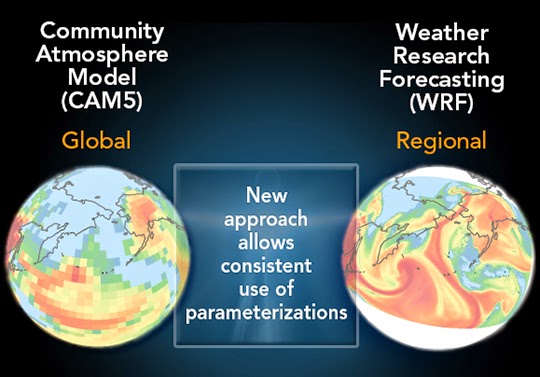
A new climate modeling approach that combines a detailed regional model with a more wide-ranging global model was developed by a team of researchers at Pacific Northwest National Laboratory, in collaboration with the University of Wyoming. This approach, described in a recent article in the journal Geoscientific Model Development, improves the way models represent atmospheric particles, clouds, and particle-cloud interactions and how they vary at regional and local scales. The approach minimizes inconsistencies in how process information is parameterized—that is, translated into simplifications that well represent process complexity.
“Our approach facilitates comparisons and produces results that agree more closely with real-world observations than previous approaches,” said Dr. Po-Lun Ma, PNNL atmospheric scientist and lead author of the paper.
Understanding the past and predicting future climate trends takes lots of computational power. Global climate models break up the planet in chunks of 100 kilometers and then average climate processes over that large grid space. Because of this large scale, scientists have struggled to accurately capture regional and local variations and extreme weather events in these models. Instead, researchers often use regional-scale climate models to characterize real-world weather events, but different representations of physical, chemical, and other processes between global and regional climate models produce inconsistent information about the atmosphere. In this study, scientists used the new modeling approach to consistently share the climate’s physical process complexities at all scales-global, regional, and local.
The PNNL research team transferred a set of Community Atmosphere Model version 5.1 (CAM5) physical parameters into the regional model Weather Research and Forecasting with Chemistry (WRF-Chem). The resulting approach allowed both the high-resolution regional model and the lower-resolution global model to share information, using the same equations and computer codes for the physical and chemical representation of clouds and aerosols and consistent estimates of emissions of gases and aerosol particles. Sharing information between the models helped the researchers understand the impact of model resolution on the simulation using a consistent framework and allowed them to avoid problems typically encountered when connecting models.
The team applied the approach at multiple horizontal resolutions over an area encompassing the northern Pacific Ocean, northeast Asia, and northwest North America for April 2008. This timeframe took advantage of the data collected by a series of field campaigns managed by the U.S. Department of Energy’s (DOE’s) Atmospheric Radiation Measurement (ARM) Climate Research Facility. The researchers then evaluated the model results against those field campaign measurements, data from satellites, and ground-based observations. The modules they created through this approach are now a part of WRF-Chem 3.5, which is available online for use by other researchers.
Scientists will use data from other field campaigns to determine which set of physical and chemical representations in the models produce results more consistent with observations and why. They will focus on simulations that explore how the scale of the model affects clouds and atmospheric particles in different climate regimes.
More information:
Ma PL, PJ Rasch, JD Fast, RC Easter, WI Gustafson Jr, X Liu, SJ Ghan, and B Singh. 2014. “Assessing the CAM5 Physics Suite in the WRF-Chem Model: Implementation, Resolution Sensitivity, and a First Evaluation for a Regional Case Study.” Geoscientific Model Development 7:755-778. DOI: 10.5194/gmd-7-755-2014
Note : The above story is based on materials provided by Pacific Northwest National Laboratory










